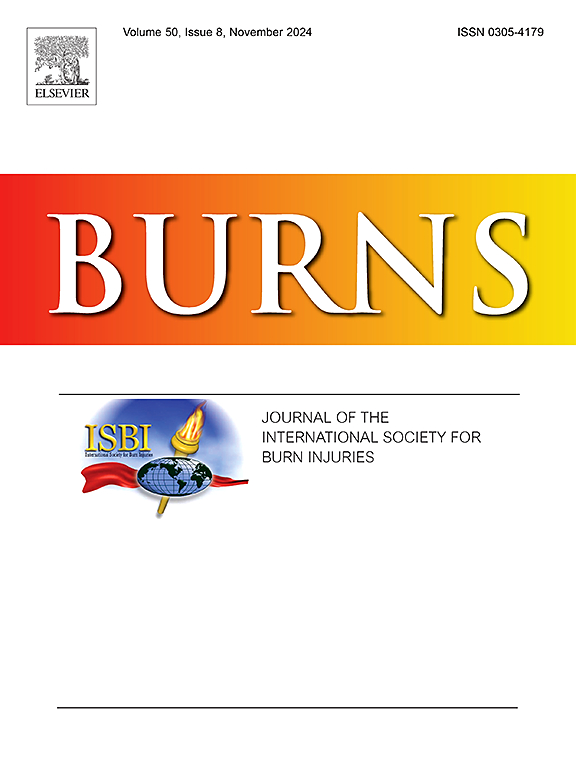成人烧伤患者疾病知觉与创伤后应激障碍的关系:认知情绪调节的中介作用
IF 2.9
3区 医学
Q2 CRITICAL CARE MEDICINE
引用次数: 0
摘要
本研究旨在探讨疾病知觉(IP)与创伤后应激障碍(PTSD)的关系,以及认知情绪调节(CER)在烧伤患者创伤后应激障碍中的中介作用。方法采用多中心、横断面研究。本研究采用有目的的抽样方法,选取中国大陆三所三级医院有烧伤史的患者。在线调查被用来收集数据。使用认知情绪调节问卷(CERQ)、简短疾病感知问卷(BIPQ)和创伤后应激障碍DSM -5检查表(PCL-5)来检查IP、CER和PTSD之间的联系。结果216例患者于2023年7月至2024年7月通过目的抽样方式完成在线问卷调查。PCL-5的平均得分为27.44 ± 13.49,BIPQ的平均得分为49.39 ± 11.71,CER阳性的平均得分为44.87 ± 16.71,CER阴性的平均得分为33.69 ± 8.59。Pearson相关分析显示,IP与PTSD呈正相关(r = 0.851,p<0.05),与CER呈负相关(r = 0.626,p<0.05)。IP不仅对PTSD有直接作用,而且通过影响正、负CER对PTSD有间接作用。结论早期烧伤患者PTSD水平较高,与IP、CER呈显著正相关,与CER呈负相关。CER在IP与PTSD的关系中起中介作用。提示医护人员需要关注患者对疾病的感知,同时也需要刺激患者采取积极的行为来降低个体的应激感知水平。本文章由计算机程序翻译,如有差异,请以英文原文为准。
Relationship between illness perception and post-traumatic stress disorder among adults with burn: The mediation role of cognitive emotion regulation
This current study explored the relationship between illness perception (IP) and post-traumatic stress disorder (PTSD), and the mediation role of cognitive emotion regulation (CER) among patients with burns.
Methods
This study is multicenter and cross-sectional. Patients with a history of burn injury at three tertiary hospitals in mainland China were selected through purposeful sampling. Online surveys were used to gather data. Cognitive Emotional Regulation Questionnaire (CERQ), Brief Illness Perception Questionnaire (BIPQ), and Post‑traumatic Stress Disorder Checklist for DSM‑5 (PCL-5) were used to examine the link between IP, CER, and PTSD.
Results
216 patients completed the online questionnaires from July 2023 to July 2024 by purposive sampling. The mean score for the PCL-5 was 27.44 ± 13.49, for the BIPQ 49.39 ± 11.71, for the positive CER 44.87 ± 16.71, and for the negative CER 33.69 ± 8.59. Pearson correlation analysis showed IP was positively correlated with PTSD (r = 0.851, p<0.05) and with negative CER (r = 0.626, p<0.05). IP not only has direct effects on PTSD but also has indirect effects on PTSD by affecting positive and negative CER.
Conclusion
Patients with burns in the early stage have a high level of PTSD, which was positively and significantly correlated with IP and negative CER, and negatively related with positive CER. CER plays a mediation role in the relationship between IP and PTSD. It is suggested that healthcare professionals need to pay attention to the patient's perception of the disease, and also need to stimulate the patient to take active behaviors to reduce the level of individual stress perception.
求助全文
通过发布文献求助,成功后即可免费获取论文全文。
去求助
来源期刊

Burns
医学-皮肤病学
CiteScore
4.50
自引率
18.50%
发文量
304
审稿时长
72 days
期刊介绍:
Burns aims to foster the exchange of information among all engaged in preventing and treating the effects of burns. The journal focuses on clinical, scientific and social aspects of these injuries and covers the prevention of the injury, the epidemiology of such injuries and all aspects of treatment including development of new techniques and technologies and verification of existing ones. Regular features include clinical and scientific papers, state of the art reviews and descriptions of burn-care in practice.
Topics covered by Burns include: the effects of smoke on man and animals, their tissues and cells; the responses to and treatment of patients and animals with chemical injuries to the skin; the biological and clinical effects of cold injuries; surgical techniques which are, or may be relevant to the treatment of burned patients during the acute or reconstructive phase following injury; well controlled laboratory studies of the effectiveness of anti-microbial agents on infection and new materials on scarring and healing; inflammatory responses to injury, effectiveness of related agents and other compounds used to modify the physiological and cellular responses to the injury; experimental studies of burns and the outcome of burn wound healing; regenerative medicine concerning the skin.
 求助内容:
求助内容: 应助结果提醒方式:
应助结果提醒方式:


